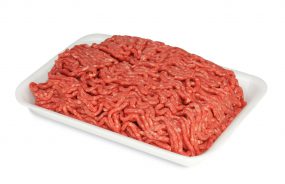2018 E. coli Outbreak Linked to Ground Beef

Posted September 20, 2018 at 5:00 PM ET
CDC, public health and regulatory officials in several states, and the U.S. Department of Agriculture’s Food Safety and Inspection Service (USDA-FSIS) investigated a multistate outbreak of Shiga toxin-producing Escherichia coli O26 (E. coli O26) infections linked to ground beef from Cargill Meat Solutions. This outbreak appears to be over.
- On September 19, 2018, Cargill Meat Solutions in Fort Morgan, Colorado recalled ground beef products.
- Recalled ground beef products were produced and packaged on June 21, 2018 and were shipped to retailers nationwide.
- Products are labeled with the establishment number “EST. 86R” inside the USDA mark of inspection.
- Visit the USDA-FSIS website for a list of recalled products [PDF – 40.2 KB] and retail locations [PDF – 240 KB] where recalled products were sold.
- Restaurants and retailers should not serve or sell recalled ground beef and should check freezers and storage for recalled products.
- If possible, retailers who received recalled ground beef should contact their customers to alert them of the recall.
- Consumers with ground beef in their freezers can contact the store where it was purchased to determine if it is recalled ground beef. Consumers with questions regarding the recall can call 1-844-419-1574.
- Reported Cases: 18
- States: 4
- Hospitalizations: 6
- Deaths: 1
- Recall: Yes
- This outbreak appears to be over.
- Eighteen people infected with the outbreak strain of Shiga toxin-producing E. coli O26 were reported from four states.
- Illnesses started on dates ranging from July 5, 2018 to July 25, 2018.
- Six people were hospitalized, including one person who developed hemolytic uremic syndrome, a type of kidney failure. One person in Florida died.
- Epidemiologic, laboratory, and traceback evidence indicates that ground beef from Cargill Meat Solutions is a likely source of the outbreak.
- On September 19, 2018, Cargill Meat Solutions recalled ground beef products that were produced and packaged on June 21, 2018 and shipped to retailers [PDF – 240 KB] nationwide. Visit the USDA-FSIS website for a list of recalled products [PDF – 40.2 KB].
- People usually get sick from Shiga toxin-producing E. coli (STEC) 2–8 days (average of 3–4 days) after swallowing the germ.
- Some people with a STEC infection may get a type of kidney failure called hemolytic uremic syndrome (HUS).
- E. coli infection is usually diagnosed by testing a stool sample.
- Antibiotics are not recommended for patients with suspected E. coli infections until diagnostic testing can be performed and E. coli infection is ruled out. Some studies have shown that administering antibiotics to patients with E. coli infections might increase their risk of developing HUS, and a benefit of treatment has not been clearly demonstrated.
- For more information, see Symptoms of E. coli Infection.
September 20, 2018
CDC, public health and regulatory officials in several states, and the U.S. Department of Agriculture’s Food Safety and Inspection Service (USDA-FSIS) investigated a multistate outbreak of Shiga toxin-producing Escherichia coli O26 (E. coli O26)infections.
Public health investigators used the PulseNet system to identify illnesses that may be part of this outbreak. PulseNet is the national subtyping network of public health and food regulatory agency laboratories coordinated by CDC. DNA fingerprinting is performed on E. coli bacteria isolated from ill people by using techniques called pulsed-field gel electrophoresis (PFGE) and whole genome sequencing (WGS). CDC PulseNet manages a national database of these DNA fingerprints to identify possible outbreaks. WGS gives a more detailed DNA fingerprint than PFGE. WGS performed on E. coli from ill people in this outbreak showed that they were closely related genetically. This means that the ill people were more likely to share a common source of infection.
As of September 19, 2018, 18 people infected with the outbreak strain of E. coli O26 were reported from 4 states. A list of the states and the number of cases in each can be found on the Map of Reported Cases page.
Illnesses started on dates ranging from July 5, 2018 to July 25, 2018. Ill people ranged in age from one year to 75, with a median age of 16. Sixty-seven percent of ill people were male. Of 18 people with information available, 6 (33%) were hospitalized, including one person who died in Florida.
WGS analysis of isolates from 13 ill people did not identify any antibiotic resistance. Standard antibiotic resistance testing by CDC’s National Antimicrobial Resistance Monitoring System (NARMS) laboratory is underway.
Investigation of the Outbreak
Epidemiologic, laboratory, and traceback evidence indicates that ground beef from Cargill Meat Solutions was a likely source of this outbreak.
In interviews, ill people answered questions about the foods they ate and other exposures in the week before they became ill. Fourteen (100%) of 14 people interviewed reported eating ground beef. Ill people purchased ground beef from several different grocery stores.
USDA-FSIS conducted traceback investigations from stores where ill people reported buying ground beef. Initial information collected from ill people in Florida indicated that the ground beef was purchased from various Publix grocery stores. On August 30, 2018, Publix Super Markets, Inc. recalled ground chuck products sold in several Florida counties.
Further traceback investigation by USDA-FSIS identified Cargill Meat Solutions in Fort Morgan, Colorado as the source of the contaminated ground beef linked to illness, including the recalled ground beef sold at Publix stores in Florida. On September 19, 2018, Cargill Meat Solutions recalled ground beef products that were produced and packaged on June 21, 2018. Products are labeled with the establishment number “EST. 86R” inside the USDA mark of inspection. The products were shipped to retailers [PDF – 240 KB] nationwide. Visit the USDA-FSIS website for a list of recalled products [PDF – 40.2 KB].
Laboratory testing identified the outbreak strain of E. coli O26 in leftover ground beef collected from the home of one ill person in Florida. WGS analysis showed that the E. coli O26 strain identified in the leftover ground beef was highly related genetically to the E. coli O26 strain isolated from ill people.
This outbreak appears to be over.



